All profits to

Archive Home Page
Previous Exhibition Following Exhibition
St. Margaret's Hall, Coniston Road, Hatherley, Cheltenham, GL51 3NU
All profits to |  |
Descriptions are based on material supplied by the layout owners
Combe Abbot Combe Abbot is a fictitious market town in Wiltshire. Its railway terminus was joint GWR and LSWR. The buildings and signals were in GWR style but LSWR traffic became dominant. At the 1923 Grouping, Combe Abbot was absorbed into the SR. The original layout was built in the 19905 in Bromsgrove. Saved from the scrap heap, it languished in a loft for seven years before being refurbished by the present owner. New features include a slimline control panel, a lighting gantry and a fiddle yard with eight train cassettes. There are currently ten trains in liveries from the late 1930s to the early 1950s. There is regular traffic to Westbury and Salisbury including through coaches to Waterloo. Freight includes milk tankers to London and military traffic to a nearby Army tank depot. A weedkilling train is based here. Track is SMP with wire-in—tube point operation. Working signals and buildings are predominantly Ratio. The ARP signal box is scratch—built. The four baseboards are held together with C-clamps and are simply supported on five new trestles, There is a Gaugemaster Combi for the trains and another for the turntable. |  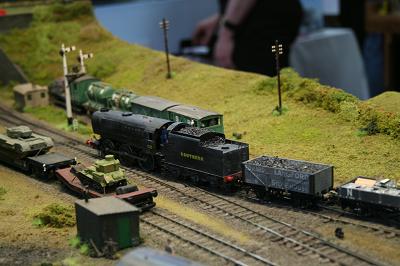 | |
  |
In its present form Condicote represents a branch line terminal somewhere in the Worcestershire area either in the late 1930's under Great Western Railway control, or in the 1950's under the auspices of BR(M) or even BR(S)! All of the rolling stock operating on the branch is either kit—built or a ready-to—run proprietary item. Everything has been fitted with Sprat and Winkle couplings (available from Andrew Hartshorne at Wizard Models) which have proved reliable and given automatic uncoupling on a layout that is hopefully free from "the hand of God". Every part of the layout has been weathered with acrylic paint, brown ink and matt varnish to create a uniform work—stained appearance. The name Condicote comes from John Masefield's novel The Hawbucks which opens with a detailed description of the station, and its timetable. | |
Earl's Court Rea|ity ... until October 3rd 1940 the LNWR/LMS had run an electric passenger service from Willesden Junction to Earl's Court. Many railway companies had, at various times, operated services over the West London Iine some of which continued via Earl's Court. The Mode|... assumes that the LMS and GWR had built their own joint station at Earl's Court. This enabled them to divert some of their commuter and local passenger trains away from Euston and Paddington. Services had continued into the early 1960's, when the model is set. As well as local services and peak hour commuter trains there is a small parcels depot and a shunt road which leads into the nearby dairy. There is also London Transport stock to be viewed on my model railway. The buildings are kit bashed or scratch built and most are loosely based on photographs from the era. Much use has been made of resin castings, which I produce myself. Locomotives include ready to run, scratch and kit built. All are detailed and weathered and fitted with sound. Earl's Court has been featured in Model Rail, British Railway Modelling and Railway Modeller magazines. You can see more information at the Earl's Court web site: ecmr.webs.com | 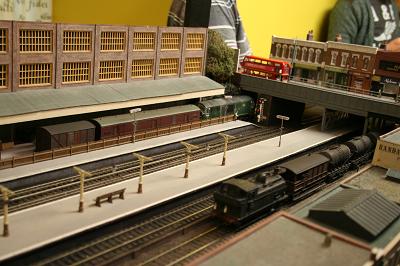 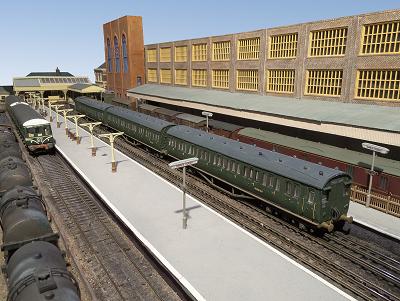 | |
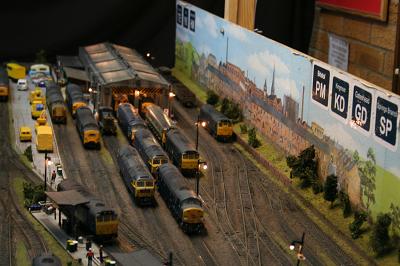 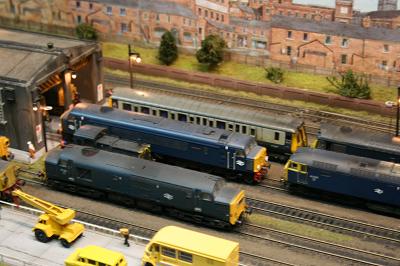 |
Eastgate is a typical motive power depot, located somewhere on the LMR. The depot services locomotives from the marshalling yards in the area. The layout is built from basic products from the main model manufacturers with Peco code 100 streamline track. Buildings are also mainly Peco, the fuelling point is from Knightwing and the personnel are made by Dapol. Everything you see can be bought from good model shops. Locomotives that can be seen are classes 03, 08, 20, 24, 25, 26, 27, 31 ,37 ,40 ,44 ,46 ,SO and 55. Here you have a lot of layout in a small space. | |
Hillside Works Hillside Works is a narrow gauge railway in 4mm scale, constructed using Peco 009 proprietary track. The location is set in the Welsh borders and the time period modelled is late sixties to early seventies. The concept and design of Hillside Works is purely fictional and an enormous amount of modeller's license has been used during all design and construction phases. The idea was to create an easily portable layout which provides sustained operational and scenic interest for the viewing public. Rolling stock is a mixture of kit built and converted ready to run items mostly from RICO and Parkside Dundas. The buildings are both kit and scratch built using Ratio and Wills materials, with various scatters from the Woodland Scenics and Greenscene ranges. The backscene has been built and painted to represent colder autumn skies and the surrounding hillsides of a typical Welsh border area. The trees are constructed using the traditional wire frame method, which is then hand soldered and covered in a plaster mix and painted to represent the bare branches that are to be found in the late November countryside of this region. Locomotives are operated by handheld controllers using DC cab control, with AC supply derived from a 15 volt transformer which has been safely electrically isolated, another transformer supplies the capacitor discharge unit, all have been hand built. The point motors are a collection of the older SEEP type and the more modern PECO type with base mounting adaptors. Working lamp posts and coloured light signals, together with their automatic control systems, have been specially constructed to scale for this layout from my own designs. Hillside Works as with all layouts is still "work in progress". Our aim for the future is to bring it into present day by turning it into a preserved railway, called Hillside Works Heritage Centre complete with working vintage machinery, tourists and cafe. | 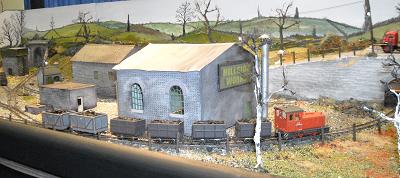 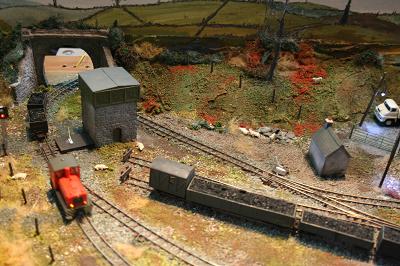 | |
 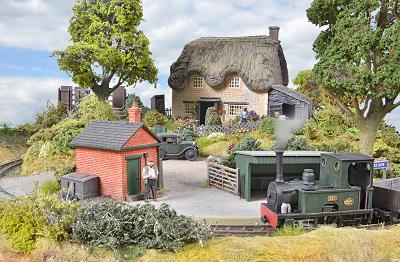 |
Hobbs Row Halt is a classic English country micro—layout, complete with thatched cottage and "chocolate box" garden. It started out as a simple circular piece of track on an MDF "Wobble Board", obtained from the local charity shop, that I used for running in new locomotives. But after placing a couple of surplus buildings from my Tansey Bank layout inside the loop to check on coach clearances, I realised that a bit of scenery would not go amiss, and Hobbs Row Halt is the end result. The cottage is from the Bachmann Pendon Little Chapel Cottage resin model and the magnificent trees are from the Realistic Modelling Materials range of ready to plant foliage. Hobbs Row Halt was featured in the August 2013 edition of Hornby Magazine. | |
London Road Locomotive Sidings London Road locomotive Sidings lie at the northern end of Westonmouth Central station, and provide a location for locomotives to stable between trips on passenger trains to and from all points on the Western Region. Diesel hydraulic types mingle with their diesel electric brothers providing constant interest and movement for the local spotters. Inspired by photographs of the cramped sidings at London Liverpool Street, the ready supply of information available on the internet produced plenty of data to design and build the layout. Whilst never claimed to be a scale replica of the original, it is hopefully recognisable, even if the 'Western" based locomotives cause some confusion. Building London Road Sidings has been a very interesting process; sometimes following a prototype is restrictive, sometimes it allows a credible setting to be created without the risks of inconsistency a fictional location brings. Being a mere 6 foot long (including fiddle yard) by a foot wide the layout sits on some low bookcases at home and allows the opportunity to “play trains” and admire favourite locomotives without the need to get involved in the complex shunting and operating procedures the builder's other layouts demand. | 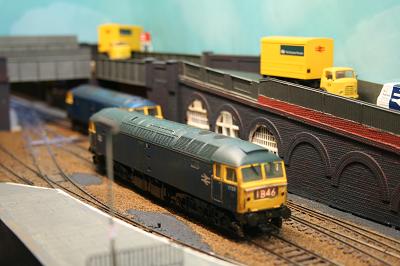 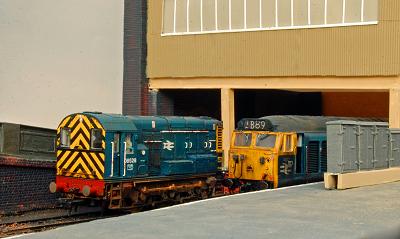 | |
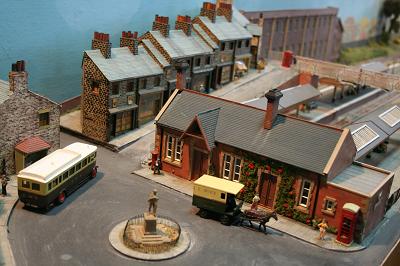 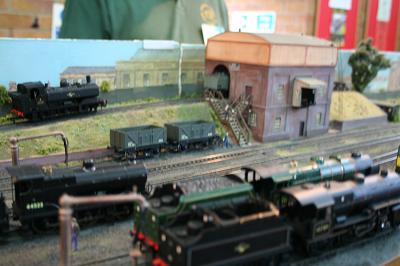 |
Phitwell End represents a small secondary terminus in a large town with the main station in the town centre. Space restrictions in the centre allowed only basic servicing facilities so the motive power depot was built near this suburban station and on a higher level. Consequently you may see, in between the passenger service, larger locomotives from the main station arriving and departing the shed area. Freight traffic is limited to coal for the MPD and local goods. A parcels service also figures in the daily activities of this busy station. The layout is capable of running Grouping or BR steam eras, depending on our fancy and the available stock from club members. It could possibly be extended into the early 70's and modern traction. In all cases we strive not to mix eras and running is controlled by a sequence card system. Construction is by traditional methods, softwood frames with plywood running surfaces and end panels. Trackwork is Peco, loose ballasted, and all fixed by white glue. Buildings are either scratch built or modified kits. What greenery there is on the layout is based on carved polystyrene blocks, covered with nappy liner, finished off with Woodland Scenics scatter and foliage materials. Trees are hand built wire skeletons, covered with modelling clay and also foliated with Woodland Scenics. | |
Snug End Snug End was inspired by a competition in the Hornby Magazine to build a diorama in 3 square feet (432 square inches). The baseboard is 45.4 ins x 9.5 ins (3 square feet) and is used at home like that, for exhibitions two small extensions are added each side to the upper level for the railbus and a third at the rear for the mainline, to change trains. The design is based on an Inglenook Shunting Puzzle and was drawn and redrawn many times to get it all to fit within the area whilst shunting with a Diesel up to Class 20/25. The track is hand built, using SMP parts and rail, directly on to the plan. All points are Ys but are different radii (e.g. 21 inch/24 inch). The base board parts were cut to size by a local building supplier from off—cuts and they only charged £9. Stock is mostly Bachmann with two sets, one has modified couplings for hands free uncoupling. The other set has been fitted with finescale (3mm) Sprat & Winkle; the S & W advice is not to use them below 36 inch radius, however they are being used here at 21 inch, but need careful setting. Control can be DCC (with sound) or DC (analogue). I find the concentration using DCC to be much harder than analogue for such a small layout and therefore sometimes like to fall back on analogue to relax. I like to think of Snug End as a Compact Layout although strictly speaking it falls within the Micro Layout category. |  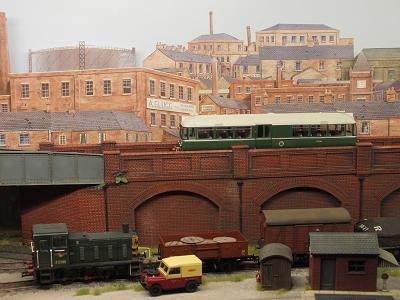 | |
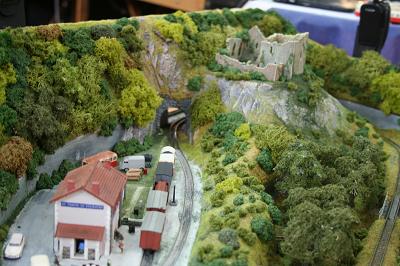 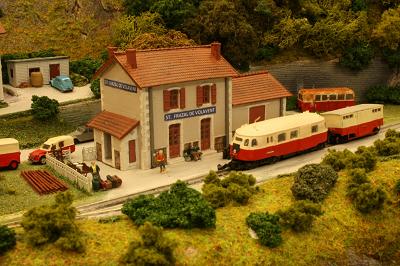 |
Nm 1:160 Scale. N Scale but running on 6.5mm Z Gauge track. N Scale Narrow Gauge. The layout is inspired by the CfD Lozere. A one metre gauge railway that once ran 30 miles through the mountains of the Massif Central in south central France. Which tunnel will the train appear from? | |
Syreford The Cheltenham & Cotswold Hills Railway company was proposed in 1811, to carry the products of the Stone Pipe Company fron Lower Guiting, to a junction with the Leckhampton branch to the horse-drawn Gloucester & Cheltenham Tramway and from thence, to Gloucester Docks. The act of parliament for the 3 ft 6 inches plateway failed at its third reading in May 1812 and the Stone Pipe Company also failed soon after, when installed systems in London and Manchester would not hold water! Syreford Station is the upper terminus of the viable part of line, had it been built for him and survived the Stone Pipe company's failure. The line has been converted to a conventional, locomotive drawn, 2 ft 4 inches gauge railway and is depicted in the early 1950's, when tourism is becoming a significant proportion of the remunerative traffic Track is hand built, using Nickel Silver Code 80 Rail and copper-clad sleeper strip. Buildings are a mixture of textured Das Pronto on plywood shells and scribed styrene sheet. Scenery is carved from a polystyrene blocks, coated with Artex and covered with commercial scatter materials, mostly from the Green Scene range, to simulate a vegetation. All the trees are home-made using twisted wire frames and Woodland Scenics foliage. The backscene is hand painted and is a view of Sandhurst Hill as seen from Sandhurst village near Gloucester. Locomotives and rolling stock are a mixture of scratch-built and kit-built vehicles, some with modified proprietary components. Passenger coaches are, at present, from the Peco range, while the larger proportion of freight wagons are from Wrightlines. The rest are scratch-built from styrene sheet. Locomotives are of various parentage; scratch built, modified proprietary, kit built and a variety of permutations, many improved with DS10 or Mashima Motors, two stage gearboxes and flywheels. All of the models on the layout, with the exception of the Platelayer's hut, have one thing in common and that it is that they are all based on a prototype, however loosely! | 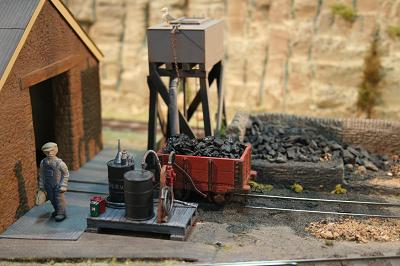 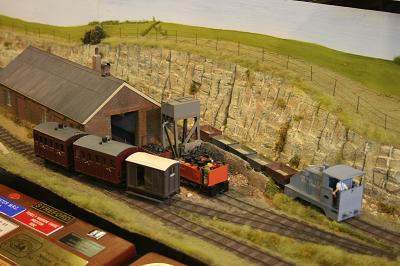 | |
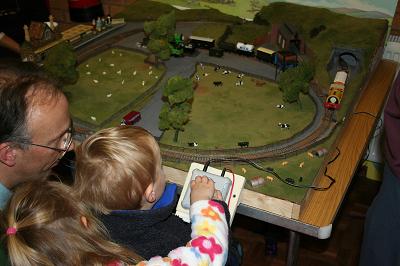 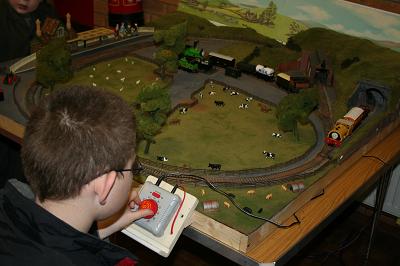 |
We would like to thank Trevor Hallam for looking after the Thomas Layout for many years at our exhibitions and also for refurbishing it at his expense. Unfortunately because of ill health Trevor is no longer able to continue so it was decided to offer Thomas free of charge to Hucclecote Railway Modellers on condition they bring it to all of our future exhibitions. This is the model railway where Children can become Engine Drivers on the Island of Sodor and has of course been inspired by the Reverend Audrey books. Our Thomas and Friends layout has been built for ten years now and in that time we hope it has encouraged many new railway enthusiasts to build a train set of their own. Originally it was intended as a space filler at shows so needed to be small, easy to transport and have a simple track plan, easy for small children to operate. After its first appearance it was clear this model railway would have to be included at all our exhibitions. It incorporates a tunnel, station, level crossing together with locomotive and goods facilities. Train drivers should look out for many of the popular characters; Henry, Percy, Toby, Cranky, the Troublesome Trucks, not forgetting the Sir Topham Hatt better known as the Fat Controller. The famous anthropomorphised rolling stock is mostly from the Thomas range and we are sure most of the adults and all the kids will love it. Happy Driving, but please observe the track speed limits. | |
Yard Shunter Yard Shunter is a DCC operated BR goods yard layout, based in the BR (Southern) region between 1948 and late 1950's somewhere in Devon during these years. A small goods yard with a private timber merchants siding has been modelled in a relatively small space, but includes a goods shed, coal merchants and a cattle pen, a run round for shunting the private siding. To exit the scenic area through the bridge to the fiddle yard, representing the entrance of the goods yard from the station beyond the bridge. Operation is DCC, there is currently a Class 08 shunter with sound, and an N class loco and a standard tank class 4MT 2-6-4, rolling stock will be expanded in the future. All track is C&L Finescale hand built with wooden sleepers, ballasted and then rails painted represent the track that would be seen at a goods yard. The major buildings are scratchbuilt, but some buildings are kits. The majority of the details are kits (plastic, whitemetal and etched-brass) and all have been painted and weathered. DCC uses a NCE PowerCab, with the points operated by servos also being DCC operated via an MERG servo 4 and accessory decoder. The locomotives are of Bachmann, (N class and a standard tank 4MT 2-6-4, diesel class 08) and represent those classes that would have been seen in Devon. The class 08 shunter has been weathered. | 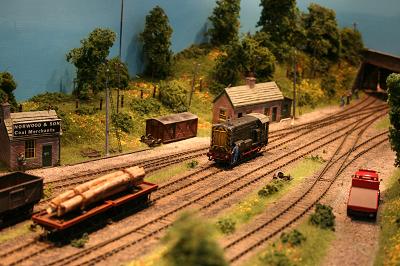 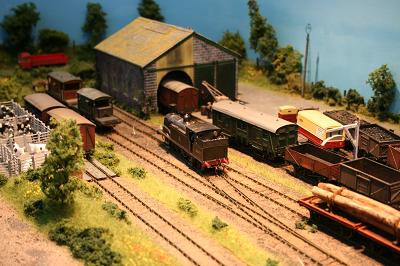 | |
| Displays | ||
Model Bus Federation WEBSITE | NARTM (road transport) WEBSITE | |
IPMS Avon branch WEBSITE | Toucan Park WEBSITE | |
| Modelling Demonstrations | ||
| Andi Dell | Mark Begley | |
| Steve Harrod | Trevor Hale | |
| Trade | ||
| Castle Trains WEBSITE | Cheltenham Model Centre WEBSITE | |
| Iron Horse DVDs | Martyn Parry (Pre-owned models) | |
| Penduke Models WEBSITE | Rly books, timetables, photos, Stewart Blencowe WEBSITE | |
| Robbie's Rolling Stock WEBSITE | ||